Breathing exercises
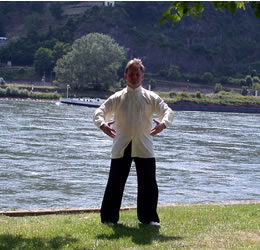
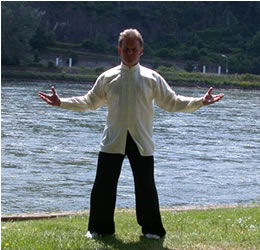
Master Instructor Volker Jung practising inner breath Qi Gong II outside the new Forum Headquarters.
Inner breathing exercises are integrated in our three main areas of study:
- Health
- Meditation
- Martial Arts
What are the benefits of breathing exercises for the practice of good Tai Chi, Qi Gong or other inner martial arts? Is there any progress in the practice of the inner arts, which can made or improved solely or to a great extent by specific breathing exercises? In order to answer these questions, we have to take a closer look at the three fundamental ways in which Chi can be moved, increased, absorbed and directed. As mentioned before, these are the following three ways:
- In general, Chi can be directed by every kind of external muscle movement, as is the case in almost all forms of sport.
- The flow of Chi can, however, also be influenced by breathing. This is effected both by the outer movement of some of the muscles just under the skin and by the movement of muscles deeper down in the human tissue, often near to bones. For this reason, breathing can be seen as a transitional exercise, leading from the outside to the inside.
- And finally, the flow of energy can be affected by mental, so-called "internal movement". This is considered the most subtle way to influence or direct the life energy Chi. Through this so-called inner or mental movement it is possible to establish contact with the ever-present stream of life energy (Chinese: flow of Qi) entirely independently of any externally materially visible movement. After one is reliably capable of consciously perceiving this continual flow of energy within onesself at any given time, one can gradually begin to deliberately influence it. At high levels of mediation, this conscious and deliberate influencing and directing of Chi knows virtually no bounds. But this can only really be judged by someone who has himself experienced it within his own body and mind.
We now want to consider what is special about breathing and its effects on the perception of energy, accumulation and increase of Chi and the direction thereof. To this end we need to take a closer look at the normal, everyday breathing habits of people with no experience of breathing techniques. A normal breath as drawn several thousand times a day is usually an almost totally subconscious process. This process may keep us alive, and very effectively so, yet during most of our daily activities we don’t even notice that we are breathing. So a standard breath will fill our lungs only to a certain extent. Exhalation is often only very superficial, depending upon the physical demands of one’s everyday life. Our "breathing autopilot" might keep our system alive, but at a relatively low level. We take in just enough Chi to cover the needs of the activity of the moment. Normally, no extra Chi is absorbed to build up, say, greater reserves of breath-Chi for hard times. Compared to that of top athletes or especially, apnea or free divers (remarkable people who dive to depths of more than 150 metres without oxygen tanks, holding their breath for up to 6 minutes), the everyday capacity of an untrained lung is absurdly feeble.
In the animal world there is the rule that: those animals which can hold their breath for long periods generally live to a ripe old age. Some species of Whale and Tortoise, for example, are able to hold their breath for more than two hours. Some types of tortoise live to be several hundred years old. On average, humans can hold their breath for half a minute. Specially trained people can manage a maximum of five or six minutes (see above). But what are two to five minutes in comparison with several hours in the animal world?
Indian yogis are of the opinion that each person has only a certain number of breaths at his disposal for one lifetime – let’s say a maximum of one hundred million breaths. After that, life inevitably ends. According to these yogis, it depends how we use this apparently endless supply of breaths over the course of a lifetime. A person who hurries through life, always out of breath, will use up the supply more quickly than someone who leads a leisurely but nevertheless busy and fulfilled life.
From a medical point of view it is definitely good for the health to increase the capacity per breath and thus decrease the number of breaths per minute, hour and day. In addition, one becomes increasingly aware of tensed up muscles which are directly or indirectly involved in the respiratory process and is better able to feel, control and utilize them.
Asian breathing exercises or Breath-Qi Gong sets (a compilation of different breathing exercises) offer us a way of learning these techniques.
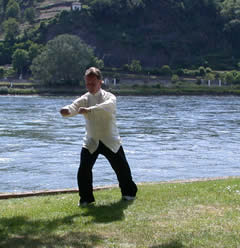
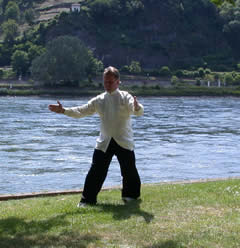
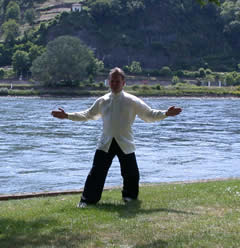
The photos show a sequence from inner breath Qi Gong with fists
Now I will attempt to plot out for you the routes open to a student or teacher setting out to learn breathing exercises. I shall do this with reference to the three paths which form the basis of our teaching:
The Health Approach
All exercises in which the attention is focussed on the breath are universally conducive to improving health and can therefore be wholeheartedly recommended. If you try to observe your breath and to increase its capacity and endurance you will inevitably meet with many problems that seem to spring up from nowhere. You very quickly realize, that although you would like to take deeper breaths, you are hindered in doing so by individual muscles or even whole groups of muscles, of which you were never previously aware. These muscles and groups of muscles seem to constrict the thorax like a kind of armour, making it wellnigh impossible to take a truly deep breath. Anyone who has ever tried to take between five and ten really deep breaths one after the other will be aquainted with the phenomenon of gasping for air like a fish on dry land. You quickly realize that flexibility is an important element of deep breathing. The muscles of the thorax in particular need to be extremely elastic if you want to be able to breath in and out deeply on a regular basis. One of my first masters used to say:
"At least 5 or 6 tense groups of muscles are a real impediment to good breathing; they can even make a true inner breath almost impossible for an untrained person".
The first task of good breathing practice is to make us aware of these tense groups of muscles in the first place using specific exercises. The second task is to coordinate these various groups of muscles to make it possible for far deeper breaths to be taken. Over the course of time, all the muscles involved in breathing become stretched, strengthened and energetically compensated. The Yin and Yang muscles and the Yin and Yang application of the muscles are described and put into practice. The ultimate goal is a soft, firm and highly efficient respiratory muscle system that won’t let you down, even after 150 or 250 high powered breaths. The supply of fresh breath-Chi to the body is greatly improved by using regular, relaxed, deep breathing. In other words, all the body cells receive more fresh oxygen than they would with inadequate breathing. In addition, extended, deep exhalation facilitates a far more effective detoxification of the body, ridding it of a far higher percentage of the toxic gases resulting from metabolic processes. This in turn, has an invigorating and strengthening effect on the internal organs, bones and muscles. So now you see why good, deep, regular breathing is such a valuable asset to good health – with every well executed breath we take, day in, day out throughout our lives.
The Meditation Approach
The main aim of this approach is not physical health. A person who practises meditation on a regular basis can generally be said to be leading a relatively healthy life already. It is usually only after a person has succeeded in giving his life a fairly healthy exterior framework that a deep inner desire for spiritual instruction arises. The ancient Greeks and Romans spoke of "a healthy mind in a healthy body“. So what contribution can breathing exercises make to the meditative advancement of a regular practitioner of meditation? ?
In the same way that physical exercises help cleanse the physical body, breathing exercises have a cleansing effect on a person‘s mental and emotional qualities. By using specific breathing exercises we can directly affect mental abilities or characteristics. Practioners of ZEN count and observe their breaths in order to gain insights into the harmony or disharmony of their own mental activities. Our otherwise often very restless thoughts are gradually calmed with the help of peaceful, gently flowing breathing. Gradually you become able to concentrate better and for longer periods – an important aspect in meditation. Taoist energy meditation teaches us to influence the movements of inner energy through various breathing techniques. Sometimes you let the Chi move faster in order to increase the amount of energy circulating per time unit. On other occasions you slow down the flow of energy in order to become more aware of it than you usually are. Some types of tension can be relieved simply by breathing very gently and slowly while practising inner visualisation. A deep breath with a fast current of Chi would tend to produce the opposite of the desired effect: too much energy might, in fact, make a problem worse rather than better. Calm, regular breathing is extremely important in maintaining the relaxed but mentally highly alert attitude which is a basic requirement for meditation. Gently flowing breathing, combined with a calm flow of energy is of great help while practising the higher forms of meditation which involve highly concentrated work on or at least attentive accompaniment of inner processes.
The Martial Arts Approach
This third approach has other aims, all of which can be achieved through deep, unified breathing. In combat it is important not to become short of breath. The highly physically demanding activities experienced during combat make it vital to train up good breathing stamina and adaptability. Here, our primary concern is not to take the longest, deepest and calmest breaths with maximum lung capacity, but rather to learn to adapt our breathing to all kinds of movements, be they slow, fast or extremely fast, whether we are running or jumping. This can be achieved through special breathing exercises in which fast in and out breaths are practised over a long period of time. A further aspect of inner martial arts training is learning to derive the energy needed for punches, pushes, kicks and throws not from normal muscular activity but from the flow of Chi in the body. With the help of breathing exercises taught in special "inner breath Qi Gong", you can learn to use your breathing to direct the flow of energy and to adapt its intensity to the intensity of your breathing. You can send the inner breath ahead of the movement, execute it simultaneously with the movement, or send it after the material movement like a motor, as it were. These are at least three of the possibilities of which we, at the Tai Chi Forum know, which can be used to support a movement through the use of inner breathing. It is obviously best to learn these techniques from someone who is well-versed in them. The inner breath Qi Gong sets in particular, together with opposite inner breath Qi Gong, are ideally suited for training this vital aspect of the martial arts. This doesn’t mean that these exercises are any less valuable for the other two approaches. Any kind of breathing work, be it outer or inner breathing, is always worthwhile, exercising and training as it does, many other positive aspects as well.
As you can see, breathing exercises as taught by the German Tai Chi Forum and the International Forum for Martial Arts (enlarged in 2003) which also teaches the five other inner arts in addition to Tai Chi, form an important part of our training and instruction. At any given time we are only one breath away from death itself. We start life with our first breath and we die with our last. Breathing is intrinsically bound up not only with life and the inner flow of our vital force, but with the drying up of this eternal flow as well.
And so it should be obvious to everyone that good, deep, regular breathing must constitute a fundamental part of a good and comprehensive training in the inner martial, meditative or healing arts. We offer a comprehensive range of appropriate exercises for each of the three branches and have over 20 years‘ personal experience of breathing exercises.